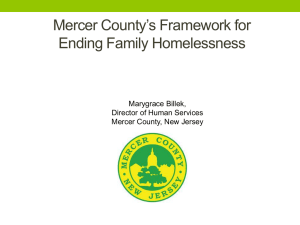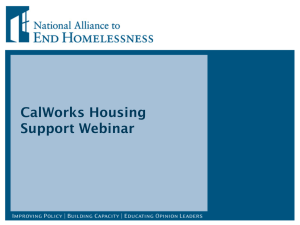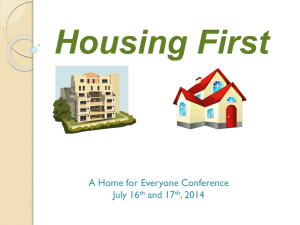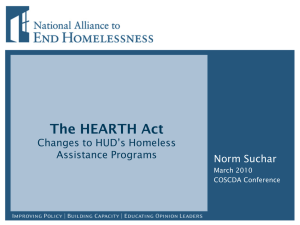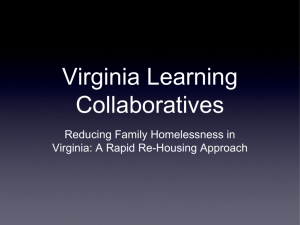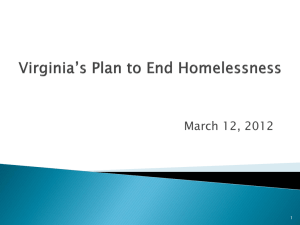Life After HPRP: Sustaining Rapid Re-Housing Programs
advertisement
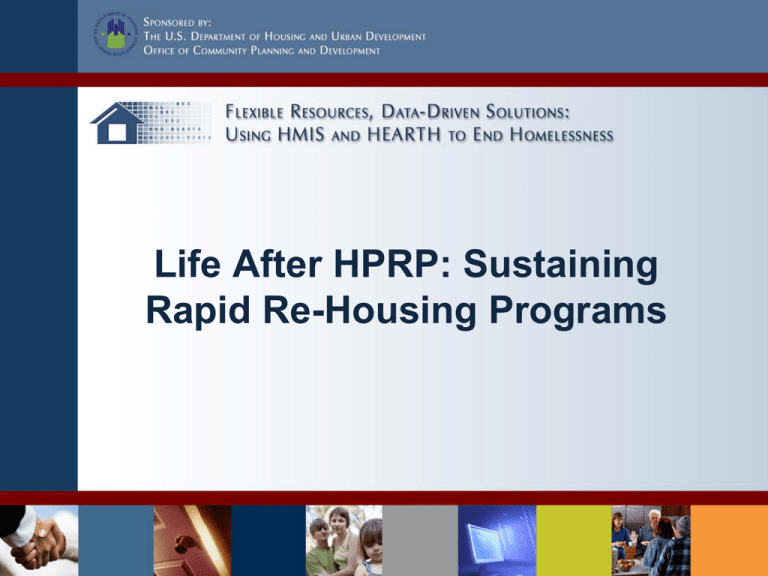
Life After HPRP: Sustaining Rapid Re-Housing Programs Presenters • Karen DeBlasio, HPRP Desk Officer, HUD • Angie Rodgers, Research & Policy Consultant Learning Objectives • Provide HPRP grantees with tips and promising practices regarding common implementation challenges. • Provide CoCs and ESG grantees with ideas about system-level changes they may wish to consider as we move forward under the next generation of the ESG program. HPRP – A Refresher HUD’s Vision for HPRP • Focus is housing stabilization – Temporary financial assistance and/or services – Bridge to long-term stability • Intent is to serve persons who: – Are homeless or would be homeless but for this assistance – Can remain stably housed after this temporary assistance ends Program Assistance Types • Homelessness Prevention – Prevent individuals and families at risk of homelessness from becoming homeless • Rapid Re-housing (Homeless Assistance) – Assist persons experiencing homelessness to be quickly re-housed and stabilized – Persons served under this category must meet the HUD homeless definition specific to HPRP Eligible Activity Categories • Financial Assistance – – – – – – Rental Assistance (including arrears) Security Deposits Utility Deposits Utility Payments Moving Cost Assistance Hotel/Motel Vouchers • Housing Relocation and Stabilization Services – – – – – Outreach and Engagement Case Management Housing Search and Placement Legal Services Credit Repair • Data Collection and Evaluation • Administrative costs (5% cap) Participant Eligibility: Rapid Re-Housing • Individuals and families who are homeless per HUD HPRP definition (must meet one of the following): – Sleeping in emergency shelter – Sleeping in place not meant for human habitation – Staying in hospital or institution for up to 180 days, but literally homeless immediately prior to entry – Graduating from/timing out of transitional housing – Victim of domestic violence Eligibility Requirements In addition to homelessness, each household must also meet two more HUD eligibility requirements: Income below 50% of Area Median Income (some grantees have chosen lower limits) “But for” prevention assistance, the household would continue to remain homeless -- because they lack the financial resources and support networks to obtain housing and they have no subsequent housing options HUD Reminder: Document Eligibility! • Assess and document income Written verification (pay stubs, benefit awards letter or direct deposit record); oral verification by a third party (employer, public assistance staff), or if no other options are possible in time to prevent homelessness, self-declaration • Assess and document housing status Written documentation (by HMIS data, written confirmation from a shelter); oral verification by a third party (shelter, etc.) or, if documentation is not possible, self-declaration (of living in a car, camping, etc.) • Assess and document “But For…” Verification or self declaration of assets; Case notes of interview with household exploring support systems and other housing options Other Documentation Issues… HUD is finding lack of documentation of cost “reasonableness” for rent, moving costs, storage costs, and motel/hotel costs. Cost comparisons should be documented. HUD expects each grantee to have policies governing the treatment of household assets—and to follow those policies consistently. HPRP cannot be used when other local, state or federal funding is being used for the same cost type and the same period of time. Files should include that the household was asked about other forms of assistance (utility assistance programs, rental subsidies, etc.). Why Rapid Re-Housing? Transforming your System of Care Why Rapid Re-Housing? • Where homelessness cannot be prevented, it can be ended quickly for the overwhelming majority of households • Most households will successfully exit homelessness with limited assistance • Households with moderate to severe housing barriers may require more intensive and/or expensive assistance to exit homelessness – but most can still succeed with temporary assistance Why Rapid Re-Housing? • An efficient and effective rapid re-housing program can: – “Open the back door,” reduce the length of time persons remain homeless, and free up critical shelter space – Create viable housing opportunities not previously available through landlord partnerships--especially for persons with poor or no credit/rental history, very low incomes and/or other housing barriers – Provide transitional stabilization assistance once a client is in their own home – Change the system’s central focus from emergency shelter to re-housing (i.e. emergency shelter is a means to an end: just a safe place to stay until a person who is homeless can be rehoused) Principles of Rapid Re-Housing • Targeting: Re-housing resources are most effective when households are quickly screened and linked to the right assistance to end homelessness as quickly as possible. RRH focus: households who need some amount of assistance for some period of time and who are not better served by another longer-term or more intensive program. • Direct Movement from Homelessness to Housing: There are no intermediate program steps that delay movement to housing. • “Just Enough” Assistance: Provide minimum amount of assistance necessary to obtain and stabilize housing. Principles of Rapid Re-Housing • Mainstream Service Linkage: Linkage to mainstream resources is critical to some households’ ability to achieve housing stability and maximizes HPRP resources. • Landlords are Most Valued Resource: Partnerships are key to rapid re-housing success. • Everyone is Housing Ready: RRH assistance helps ensure a CoC is ready and able to re-house households who are homeless. CoC Challenge CoC Opportunity Provide the right resources to the right people at the right point in time for the right amount of time. Transform CoC to more effectively and efficiently prevent and end homelessness How is Rapid Re-Housing transforming CoCs? Common Challenges & Solutions Implementation Challenge #1: Targeting • Targeting is extremely critical if a rapid re-housing program is to be both successful and cost effective. • The challenge is to quickly identify those who are best served by rapid re-housing (vs exiting homelessness on their own or through other programs). • Screening for rapid re-housing assistance may require assertive outreach or in-reach with an emphasis on finding the right programmatic “fit” to end. homelessness as quickly as possible, Create the services to fit the people rather than looking for the people to fit a rigid program model. Targeting & Streamlining Access to Re-Housing Assistance… • Los Angeles, CA: – “Vehicular outreach team” contacts homeless families and individuals living in vehicles and refers them to geographically dispersed assistance centers. • Memphis, TN: – All shelter clients assessed/engaged by RRH staff within two weeks of shelter entry • State of Indiana: – State ESG grantees required to have MOU with local HPRP provider, which ensures coordination with local shelters and local HPRP provider Example: Efficient Targeting & Linkage Family loses housing Doubles up with friends or relatives Calls Central Intake for homeless services Housing Search Diverted with referral to prevention & stabilization services Enters public or private shelter Rapid Re-Housing Team assesses housing barriers Re-Housing Advocate works with family to locate and secure housing, including financial assistance. Re-Housing Advocate helps family stabilize Family moves into housing Implementation Challenge #2: Rapid Housing Placement • Focus on identifying and addressing barriers – Tenant screening barriers: what a landlord will use to ‘screen out’ applicants – Housing retention barriers: problems that caused past housing loss and may cause future housing loss • Know the rental market and establish partnerships – Landlords are essential partners – identify and develop lasting, mutually beneficial relationships – Staff must be housing market “experts” – awareness of options and knowing how to access all types of housing options is job #1 – Tailor landlord “incentives” to fit the local housing market, landlords risktolerance and the client’s barriers – Consider specializing staff functions (e.g. Housing Locator) • Client Housing Plans – Keep focus on housing placement and specific barriers to address related to placement Rapid Housing Placement • Palm Beach County, FL: – “Housing Specialist” recruits landlords and inspects units – On average, place families within 7 days of program approval • Pasco County, FL: – Use moving assistance, rental and utility assistance to move clients into housing quickly – Some landlords with higher vacancy rates reduce rents = mutual benefit Implementation Challenge #3: Transitioning to Stability • Rapid re-housing assistance not intended to resolve all of the household's ongoing barriers and financial needs. • Linkage with mainstream resources is key to meet ongoing needs beyond term of RRH assistance. • Assuring households can sustain housing does not mean households will no longer experience housing or life problems or that they will achieve “affordable” housing. Transitioning to Stability… • State of Indiana: – Focus on providing “just enough” assistance to assure housing stability and reduce future risk – Use of standardized Housing Case Management plan with emphasis on optimizing household strengths • Pima County/Tuscon, AZ: – Coordinate with VASH to provide security deposit – Used to secure housing while inspection is completed Implementation Challenge #4: Continuous Improvement • • Programs/systems learn by doing and make adjustments to improve performance. Identify key performance indicators and targets related to system/program effectiveness, efficiency, quality, and access. – – – – – • Average length of time homeless Amount and duration of assistance Successful housing outcomes Recidivism Client satisfaction At least annually, review and analyze data to assess changes in target population, outcomes, costs, and satisfaction. Then use results to develop a program improvement plan. Continuous Improvement • Sacramento, CA: – Success = assessment within 72 hours of entry and re-housing within 20 days • Miami, FL: – Use “Lean Six Sigma” model for tracking performance at every step – process efficiency, staff performance, system performance – Feeds into ongoing ‘scorecard’ • Memphis, TN: – Meet monthly to review data – Front-line staff meets weekly on shared cases • Boston, MA: – Use technical service provider to conduct monthly trainings – Serves as forum for peer-to-peer learning and review of difficult cases HPRP In Virginia • HUD funded $11.4M to the state of Virginia. • The state funds were administered by VA DHCD. • VA DHCD granted the state funds to nonprofit or municipal entities in 23 jurisdictions. • Additionally, 13 entitlement communities received $13.4M from HUD. • A new study by VCEH examines implementation of HPRP in 8 of these VA communities. • The study focuses on the rapid re-housing portion of each community’s programming. • It details each community’s successes, challenges, and post-HPRP plans for rapid re-housing. VCEH Study Methodology The study covers: • Arlington County, Chesapeake, Fairfax County, Franklin County, New River Valley, Richmond, Roanoke and Virginia Beach. The study uses: • HUD reports for the quarter ending 06/30/2010; and • Interviews with government staff and nonprofit service providers. VCEH Study Findings • Experiences in VA largely affirm national claims about the success of rapid re-housing. • “Housing locators” identified as key factors of success in all of the communities using them. • Case management is more successful when it can focus on the root causes of housing instability. • Communities have better outcomes when all of the different services and systems that affect homeless persons are collaborating. • The mix of short-term subsidy, assistance finding housing, and case management is a successful mix for most persons experiencing homelessness. • More resources all around would be needed to take rapid re-housing to scale. • Permanent housing subsidy and long-term case management would be needed to stabilize people with chronic barriers. VCEH Study Findings – Housing Locators • The underlying principle is that housing locators contribute to success because they develop and maintain relationships with landlords willing to accept renters with challenges. • 5 of the 8 communities in the study are using housing locators/brokers. • Locators/Brokers: • allow communities to be proactive about stabilizing homeless persons in permanent housing; • free up case management staff to focus on a person’s reasons for being homeless; • Encourage landlords to rent to their referrals because they know the locators will remain part of the arrangement until the person is stable. • Case Study: Arlington added 18 LLs to their pool as result of their housing locator’s efforts. VCEH Study Findings – Case Management • The underlying principle is that case management that focuses on the root cases of housing instability creates better odds that the person will maintain their housing long-term. • All of the communities in the study are doing case management. • Case managers in communities without separate housing locators still have to spend a lot of time on the details of actually getting people housed. • These communities typically report a desire for more resources that will allow their case managers to focus more on employment, health and other barriers. • Case Study: Fairfax County deployed “community case managers,” who work regionally across a number of nonprofits. VCEH Study Findings – Collaboration • The underlying principle is that all of the services and systems affecting homelessness should work together. • Collaboration reduces duplication of effort, and ensures that every entity is deployed according to its capacity and competency. • Many jurisdictions had already begun planning as part of their 10 Year Plan process or Continuum of Care. • In the best examples, government staff and nonprofit service providers collaborated on applying for the funding, and continued to collaborate on implementation and accountability. • Case Study: VSH, having been asked to implement HPRP in some jurisdictions around the Richmond region that were new service areas for them, collaborated with existing service providers, school systems, etc. to reach their target population in these new areas. VCEH Study Findings – Taking Rapid Re-Housing to Scale • 5 of the 8 communities in the study have solid plans to continue their rapid re-housing program, in whole or in part, once HPRP runs out. • Funding is an issue, and communities are looking to a variety of resources, but few have concrete options at this point. • Rapid Re-housing programs could also serve homeless persons who need long-term assistance. • Most communities haven’t done this with HPRP, but will begin to explore with whatever resources are available to take HPRP’s place. • Such an expansion will require more permanent resources. • As communities look to expansion, there are important questions to continue asking. VCEH Study Findings – Taking Rapid Re-housing to Scale QUESTIONS • Is rapid re-housing cheaper than the alternative? • Does rapid re-housing stabilize people faster than the alternative? • What are the benefits associated with faster stabilization? • Are the benefits the same or greater for both episodic and chronic homelessness? VCEH Study Findings – Taking Rapid Re-housing to Scale QUESTIONS
